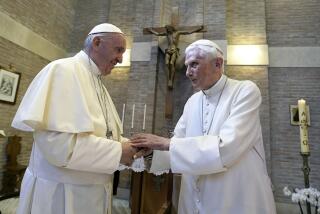Ritualized vote will choose successor to Pope Benedict XVI
The Roman Catholic Church will choose a new pope after Pope Benedict XVI announced his plans to resign Monday in a ritualized system of balloting with a long history.
The pope is chosen through a closed, elaborately regulated gathering called a conclave, which brings together cardinals at the Sistine Chapel. The new pope will be chosen in unusual circumstances, since it has been centuries since a pope has stepped aside.
The conclave normally begins 15 days after the death of the pope, and can be held no longer than 20 days after his passing; a Vatican spokesman said Monday. The exact date had yet to be set, but âobviously there will be no need to wait the normal eight days of mourningâ and a new pope would be chosen âin time for Easter.â
PHOTOS: Pope Benedict XVI to step down
Cardinals who are younger than 80 are allowed to take part in the election; Benedict XVI himself, who is 85, will not be involved, the Vatican said. Some other people are also allowed into the gathering, including nurses for ailing cardinals, but they must swear to âabsolute and perpetual secrecyâ about the proceedings, according to Rev. Thomas J. Reese, S.J., senior fellow at the Woodstock Theological Center at Georgetown University.
The cardinals themselves also take an oath pledging to keep proceedings secret and to prevent interference in the balloting. After the oath is taken, Reese writes, the Sistine Chapel is closed to outsiders with the Latin words âExtra omnesâ â âEverybody out!â
Choosing a pope is so secretive that the Vatican has had the Sistine Chapel wired with electronic jamming devices to stop eavesdroppers, The Times reported in 2005. The cardinals spend their nights sequestered at St. Marthaâs House next to St. Peterâs Basilica. There, they are banned from communicating with people outside the conclave and forbidden from reading newspapers, listening to the radio or watching television.
Inside the chapel, the cardinals cast ballots until two-thirds agree on the same choice. Each cardinal writes his choice on a rectangular ballot printed with a Latin phrase meaning âI elect as Supreme Pontiff,â disguising his script to thwart anyone from identifying the writer. He then folds the ballot twice and brings it to a receptacle on the chapel altar.
âScrutineers,â chosen among the cardinals each morning and each afternoon, record and read out the names on the ballots as they are unfolded. The ballots are then threaded onto a string; once all the ballots are read out, its ends are tied together.
FULL TEXT: Pope Benedict XVIâs announcement
Voting can begin as early as the first afternoon of the conclave. If no pope is chosen the first day, the conclave continues, with two votes each morning and two each afternoon.
The ballots are burned after the votes. Black smoke shows that a vote is not conclusive; white smoke signifies that a new pope has been elected. Scholars say chemicals are now used to darken the smoke, once achieved by mixing wet straw into the ballots.
Bells also toll to announce the selection of a new pope, since the color of the smoke is sometimes difficult to discern.
Elections can be lengthy. Voting can be suspended for a single day of prayer and discussion if the cardinals have not chosen anyone after three days.
The rules shift if the cardinals struggle to reach agreement. Benedict tweaked the rules six years ago to allow runoffs between the two leading candidates if the cardinals have not chosen a pope after 13 days. The winner must still get two-thirds of the vote. The decision rolled back an earlier change by Pope John Paul II, who had altered the rules to allow the pope to be chosen with a simple majority if indecision persisted.
Once the new pope is chosen, he is asked whether he accepts the election. When the voting is finished, the only written record of the election is a single document, sealed in an envelope that cannot be opened unless the pope gives his permission, Reese writes.
The new pope is announced with the words âHabemus Papam!â -- Latin for âWe have a pope!â -- before he appears overlooking St. Peterâs Square to impart his first apostolic blessing.
ALSO:
Pope confided in brother about his infirmity
Pope Benedict XVI to become first pope in 600 years to resign
Gen. Joseph Dunford becomes U.S. commander in Afghanistan
More to Read
Sign up for Essential California
The most important California stories and recommendations in your inbox every morning.
You may occasionally receive promotional content from the Los Angeles Times.










